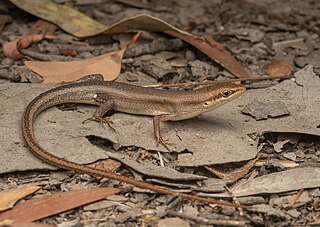
Carlia is a genus of skinks, commonly known as four-fingered skinks or rainbow skinks, in the subfamily Eugongylinae. Before being placed in this new subfamily, Carlia was recovered in a clade with the genera Niveoscincus, Lampropholis, and others of the Eugongylus group within Lygosominae.

Papilio leucotaenia, the cream-banded swallowtail, is a species of butterfly in the family Papilionidae. It is found in the Democratic Republic of the Congo, Burundi, Rwanda, and Uganda. The habitat consists of forests at altitudes ranging from 2,100 to 2,300 meters.

Pholidichthys leucotaenia, commonly known as the convict blenny/goby or the engineer blenny/goby, is a marine fish from the west-central Pacific Ocean. Despite its common names, it is neither a blenny nor a goby, but is in fact one of two species in the family Pholidichthyidae.

The Black Mountain rainbow-skink is an endemic species that inhabits a total of 6 km2 (2.3 sq mi) on Kalkajaka in Queensland, Australia. The species is 70 mm long with a weight between 4 and 6 grams. This species goes through oviparous reproduction.
Echidna leucotaenia, the whiteface moray, also known as the white-banded moray eel, is a moray eel. It was described by Schultz in 1943. It is a tropical, marine and freshwater eel which is known from the Indo-Pacific, including East Africa, the Line Islands, the Tuamotu Islands, and Johnston Island. It dwells at a depth range of 0 to 24 metres, and leads a benthic lifestyle in reefs. Males can reach a maximum total length of 75 centimetres (30 in).
South West Osborn Island is an island off the coast of the Kimberley region in Western Australia.

The desert rainbow-skink is an Australian skink in the genus Carlia, commonly known as four-fingered skinks, from the subfamily Lygosominae. It is native to desert woodland regions throughout most of the Northern Territory, the north of Western Australia, and the far north-west of South Australia. It was originally classified as Leiolopisma triacantha, and is sometimes known as the three-spined rainbow-skink.

Carlia longipes is a species of skink, commonly known as closed-litter rainbow-skink, in the subfamily Eugongylinae.

Goby is a common name for many species of small to medium sized ray-finned fish, normally with large heads and tapered bodies, which are found in marine, brackish and freshwater environments.

Eugongylinae is a subfamily of skinks within the family Scincidae. The genera in this subfamily were previously found to belong the Eugongylus group in the large subfamily Lygosominae.

Carlia ailanpalai is a species of skink, commonly known as the curious skink, in the genus Carlia. It is native to Papua New Guinea. It has been introduced to Weno Island and Guam.
Carlia beccarii is a species of skink, a lizard in the subfamily Eugongylinae of the family Scincidae. The species is endemic to Indonesia.
Carlia insularis, the Kimberley islands rainbow-skink, is a species of skink. It is endemic to the islands of the Bonaparte Archipelago in the Kimberley region of Western Australia. It measures 28–51 mm (1.1–2.0 in) in snout–vent length.
Carlia isostriacantha, the Monsoonal three-keeled rainbow-skink, is a species of skink. It is endemic to Australia; most records are from the Kimberley region in Western Australia, but there are also some records from the border area between the Northern Territory and Queensland. It measures 25–49 mm (1.0–1.9 in) in snout–vent length.
Carlia inconnexa, the Whitsunday rainbow skink, is a species of skink in the genus Carlia. It is endemic to Whitsunday, Hook, and Lindeman Island in Australia.
Carlia johnstonei, also known commonly as the rough brown rainbow-skink, is a species of lizard in the family Scincidae. The species is endemic to the Australian state of Western Australia.
Carlia mysi is a species of skink, commonly known as Mys' rainbow skink. It is endemic to Papua New Guinea and occurs in both mainland New Guinea and in the Bismarck Archipelago. Populations believed to be introduced exist in the Solomon Islands.
Carlia quinquecarinata is a species of skink, commonly known as the five-keeled rainbow-skink or five-carinated rainbow-skink, in the genus Carlia. It is endemic to Darnley Island in Australia.

Carlia rubrigularis, the red-throated rainbow-skink or the northern red-throated skink is a species of skink in the genus Carlia. It is endemic to Queensland, Australia.

Carlia storri, also known commonly as the brown bicarinate rainbow-skink or Storr's carlia, is a species of lizard in the family Scincidae. The species was first described by Glen Joseph Ingram and Jeanette Covacevich in 1989. It is native to Papua New Guinea and the Australian state of Queensland.










